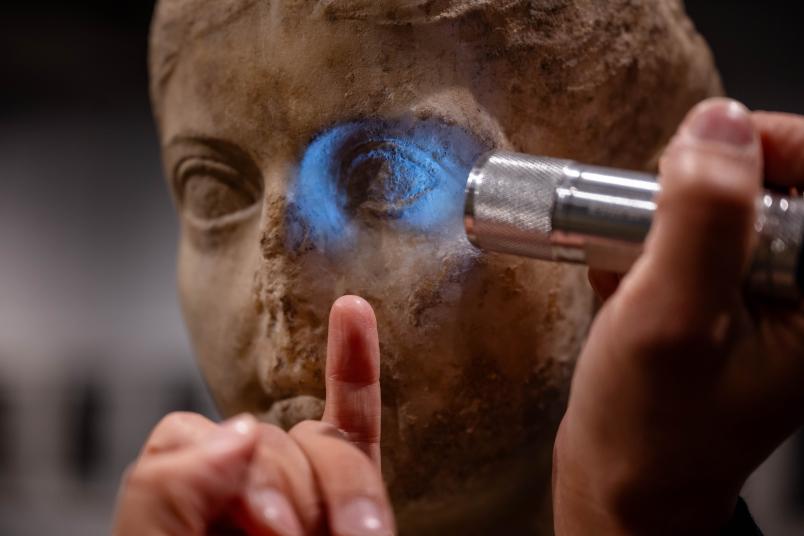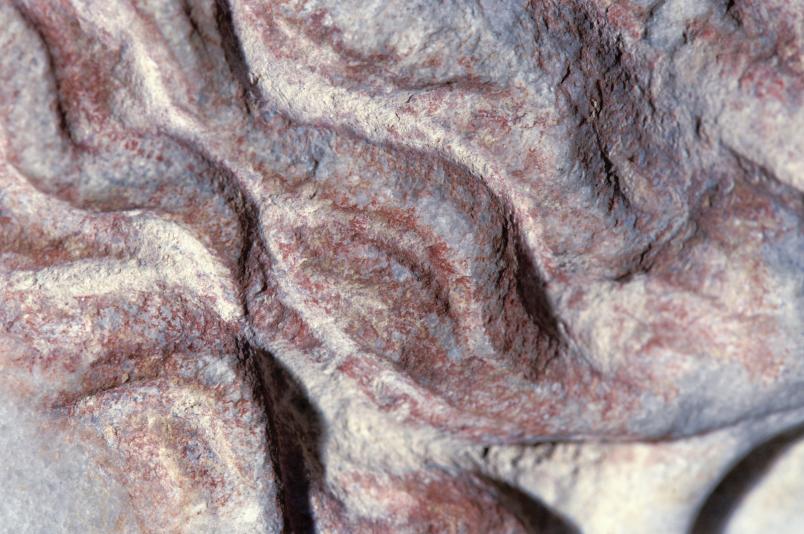Archaeology
Eye to Eye with the Gods
Ancient Greek statues look white and aloof only in the eyes of posterity. In their own era, they used to be painted; some were even adorned with jewelry and clothes, making them look like the people around them.
Aloof, white and still: This is what Hellenistic marble statues look like when we encounter them in museums, and this is also how they were imitated in the Classicist period. But at the time when they were created, they didn’t look like that at all. “Their stone surface was decorated with a variety of textures, painted in different colors; some wore real clothing and jewelry or weapons made of metal and probably also wood and other materials,” explains Dr. Clarissa Blume-Jung from the Institute of Archaeological Studies at Ruhr University Bochum. Some of these decorations have been preserved, but not very well. The archaeologist therefore takes a close look to find any tiny residues. “It’s like a jigsaw puzzle,” she says, describing her investigative search for clues.
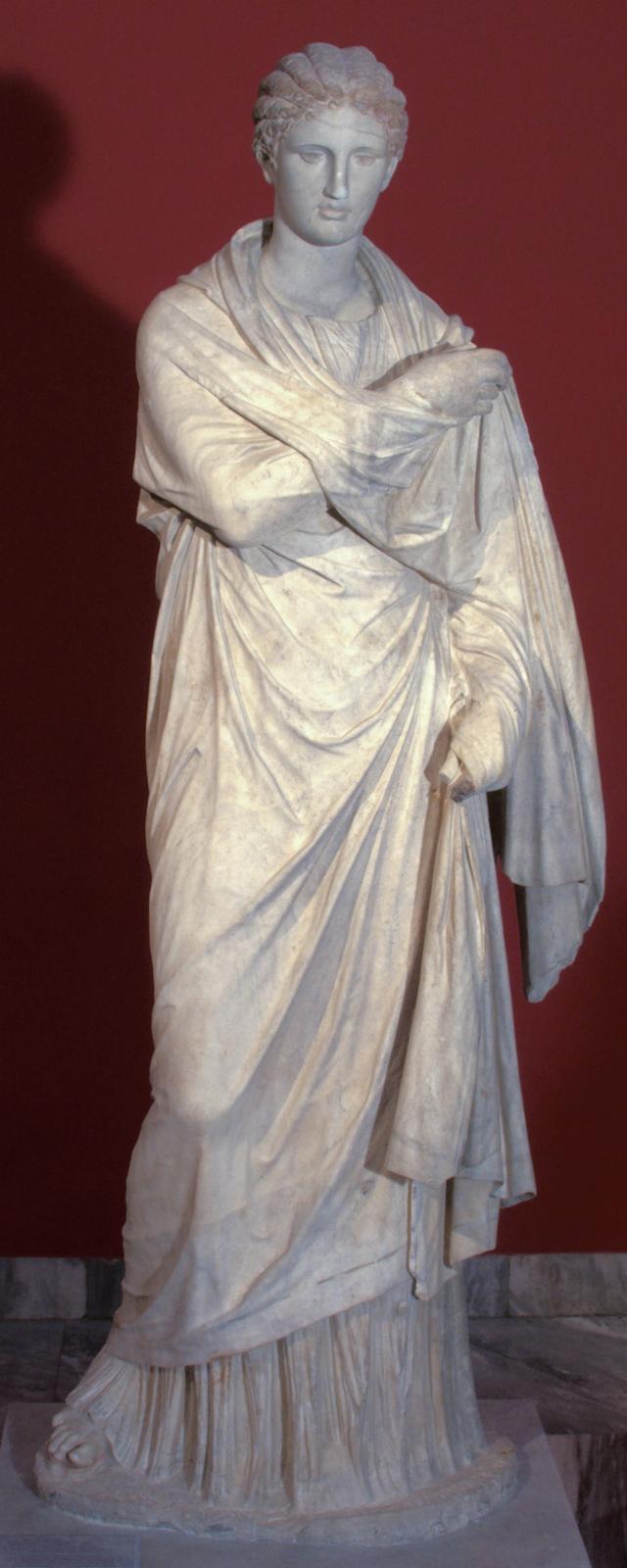
Her work focuses on objects from the period between around 323 and 31 BC. Before this so-called Hellenistic period, which lasted around 300 years, Alexander the Great had expanded his global empire as far as India, Afghanistan, Pakistan and North Africa. A new taste emerged. The statues examined by Blume-Jung represent, for example, young women in opulent robes, athletes, children, rulers or deities; they stood, depending on their function, in sanctuaries, public squares and even in the homes or gardens of wealthy families. “Most stone statues were made of marble. The most popular was Parian marble, which is very finely crystalline and uniformly white and is moreover easy to work with,” says Clarissa Blume-Jung. Examples can be found on the Greek island of Delos in the Aegean; it used to be inhabited, before being so badly destroyed after several earthquakes that it was abandoned. Today it is a UNESCO World Heritage Site.
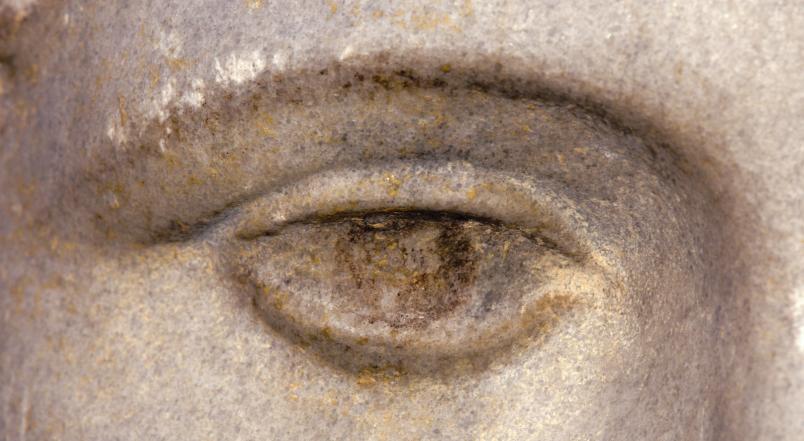
It was here that the statue of a woman was discovered, which stood in a private house in a room that opened onto a covered portico around a garden and is now displayed in the National Museum of Athens. At first glance, it looks monochrome. But if we take a closer look, we see that the hair appears darker than the face. “The hair is coarse in texture and not smooth like the face,” points out Clarissa Blume-Jung. “You can tell that the strands of hair are painted with at least three different shades of brown and ochre – we can even see individual brushstrokes in some places. The sculptor and painter worked hand in hand to shade the hair, which means that it probably looked really lifelike.”
Polychromy
Ear holes provide a clue
The dark iris of the eyes is still clearly visible, as is the hairline of the eyelashes. “It’s easier if you know what you’re looking for,” says Clarissa Blume-Jung, who’s compared the statue with many others and also drew on examples from painting, small-format terracotta figures and other genres. That’s how she was able to reconstruct that the object held in the woman’s left hand could have been the handle of a fan. “Unfortunately, accessories made of wood and other perishable materials have not survived the passage of time,” she says. “Metal ornaments are usually long gone as well – presumably because the material was required for other purposes and was melted down.” And yet, Blume-Jung is convinced that they existed: “If a statue has pierced ears, you can assume that it also wore earrings,” says the researcher.
The garment covering the statue from Delos, which wears an undergarment with a rectangular cloth pulled bashfully over her shoulders – a frequently depicted pose – provides yet more clues about colors. “In some places, you can see jagged, blackish traces of the original ornamentation of the cloak, which are probably paint residue, but could also be the primer for a gold coating,” explains Clarissa Blume-Jung. In any case, the edge of the narrow side of the cloak shows traces of gold, which alternate with traces of weathering that are now purple. The soles of the sandals were designed in three color segments, creating a three-layered sole.
Light blue and pink were all the rage
“The paints were mostly natural pigments,” says Clarissa Blume-Jung. “Ochre comes in red and yellow, for example, as well as in other shades. Green was mostly derived from malachite, and pink was usually extracted from madder root.” These and other natural dyes were also mixed to create a wider color palette. “Light blue and pink were all the rage in the Hellenistic period, both for men and women,” points out Clarissa Blume-Jung. She can make the pink color obtained from madder root clearly visible under UV light. Azurite was sometimes used for blue hues. The common practice, however, was to use the artificially produced pigment Egyptian blue. Thanks to infrared photography (using the so-called VIL technique), it’s even possible to make traces of the color visible that the human eye would otherwise no longer perceive. In addition to examining the stone closely with the naked eye, Clarissa Blume-Jung uses a reflected light microscope, various photographic techniques and grazing light. Illumination from the side reveals tiny elevation differences in the stone. This is due to the fact that one color has been preserved longer than the other, thus protecting the stone from weathering for a longer period of time. For example, a line may be preserved around the iris in the eyes. Or the pupil is slightly raised. Color analyses are only commissioned in individual, carefully considered cases.

If that’s not proof enough, there’s also tangible evidence that the statues came in a variety of colors and decorations: “Inscriptions have been found on shrines listing the exact expenses, probably so that the donors could keep track of how their money was spent,” says Clarissa Blume-Jung. “For example, the ’completion’ and ’repair’ categories of a particular statue often include entries such as ’painting’ or ’colors’.”
Gods with skin of gold
There was perhaps one difference between how gods and humans were depicted: the skin. Clarissa Blume-Jung has found statues with traces of paint on their skin as well as statues with traces of paint on their hair and clothing, but not on their exposed skin. “Perhaps the white marble on individual statues was left unpainted or simply covered with wax,” she speculates. “What is certain is that statues of gods sometimes came with gilded skin, whereas statues of humans usually did not.”
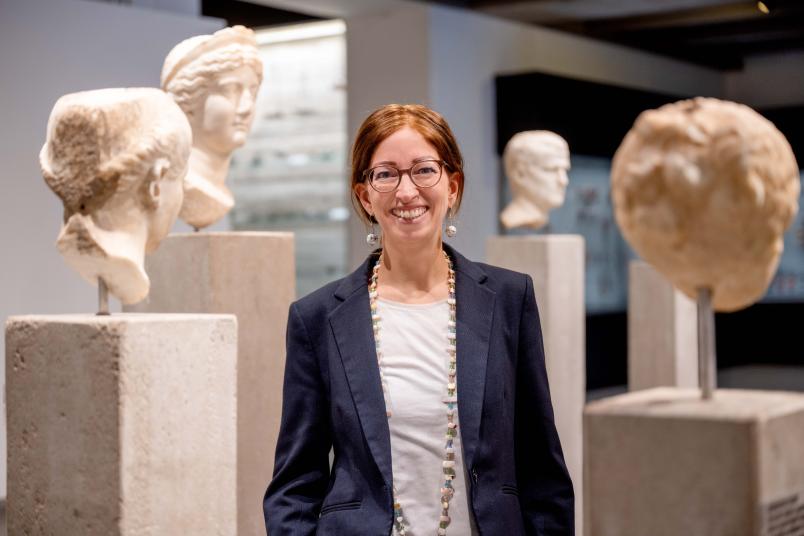
The researcher is convinced that the way the statues were once perceived was fundamentally different from how they appear today. “Imagine walking into a temple, where the statues of the gods may be tall, but otherwise look human – it’s a very different experience to how they look today, all white and aloof. By making them look more human, they feel closer to us. This is also reflected in how the gods were portrayed in literature in ancient Greece.”
